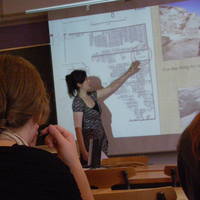Rachael J Dann
University of Copenhagen, Carsten Niebuhr Department, Faculty Member
- Archaeology, Egyptology, Death and Burial (Archaeology), Archaeological Theory, Ancient Nubia, Nubiology, Late Antique, History and Archaeology of Africa, and 9 moreFunerary Archaeology, Anthropology of Death, Human sacrifice (Anthropology Of Religion), Deviant burial (Archaeology), Animal Sacrifice (Anthropology), Qustul, Ballana, X-Group, and Identityedit
- I am a former Associate Professor of Egyptianedit
Research Interests:
The X-Group (or Post-Meroitic) Period in Lower Nubia is a period of cultural continuity from the previous Meroitic Period, while also being a period of significant change and innovation. X-Group culture is characterized in the elite... more
The X-Group (or Post-Meroitic) Period in Lower Nubia is a period of cultural continuity from the previous Meroitic Period, while also being a period of significant change and innovation. X-Group culture is characterized in the elite sphere by forms of material culture that frequently combine motifs with Egyptian, Classical, and Kushitic antecedents in inventive ways, long-distance trade relationships and monumental building projects in the mortuary domain. In both elite and non-elite circles a distinctive pottery tradition endures, and ritual practices focused at sites with long genealogies continued. The introduction of the waterwheel in Lower Nubia enabled an expansion of agricultural cropping regimes and supported settlement in the region, which was frequently based at sites that had seen Meroitic Period activity, although there is frequently a gap in the chronology rather than direct temporal continuity.
The current program of fieldwork at and around the Kushite royal cemetery of el-Kurru began in 2013 and has continued to investigate features previously excavated by Reisner and to broaden our knowledge of the cemetery, its local context,... more
The current program of fieldwork at and around the Kushite royal cemetery of el-Kurru began in 2013 and has continued to investigate features previously excavated by Reisner and to broaden our knowledge of the cemetery, its local context, and its later history (Emberling and Dann 2013; Emberling et al. 2015). This report contains four sections. First, a study of the geology and hydrology of the local area, both of which have continued to affect archaeological remains and their preservation. Second, a report on continuing excavation along what Reisner called the “city wall” – more accurately called a town wall given its size. Reisner assumed it to be contemporary with the royal pyramids of the 8th-7th centuries BC, but we have found it in fact to be a fortification of Medieval (Christian) times. Excavation of this area has also recovered settlement and burial remains. Third, a brief report on an archaeobotanical study in the Medieval settlement. Finally, a report on an innovative cro...
Research Interests:
Despite the richness of the record relating to the art, texts, and archaeology of the Sudanese past there has been a lack of explicit study or theorization of the human body. There is much potential and scope for a discussion of how the... more
Despite the richness of the record relating to the art, texts, and archaeology of the Sudanese past there has been a lack of explicit study or theorization of the human body. There is much potential and scope for a discussion of how the body has been represented through time, but also for how the body as the medium through which the social is experienced has been constructed and has changed through time. A range of possible approaches to the study of the human body are presented here.
Research Interests:
This paper considers the difficulties and creativity involved in interdisciplinary collaboration. Based on some of the outputs generated from shared time spent at the UNESCO World Heritage site of El Kurru in Sudan, the common elements of... more
This paper considers the difficulties and creativity involved in interdisciplinary collaboration. Based on some of the outputs generated from shared time spent at the UNESCO World Heritage site of El Kurru in Sudan, the common elements of both artistic and archaeological work are explored. By reflecting on certain methods and materials a version of our practices emerges from the assemblage of the archaeological site, one which is deeply engaged with sensorially based responses to it. It draws on the work of the artists in residence Florian Roithmayr (Reading University) and Mel Jackson (Slade School of Art)
Research Interests:
Research Interests:
Research Interests:
Research Interests:
Research Interests:
Harry Wallop is the author
